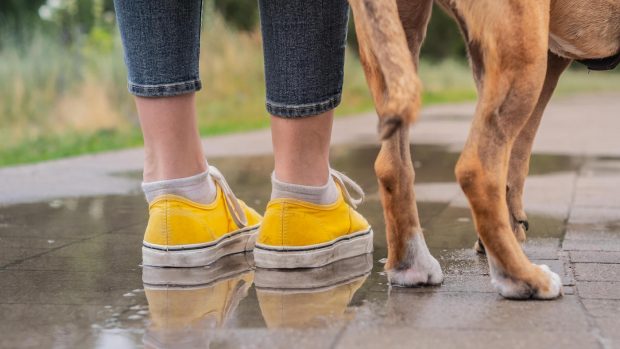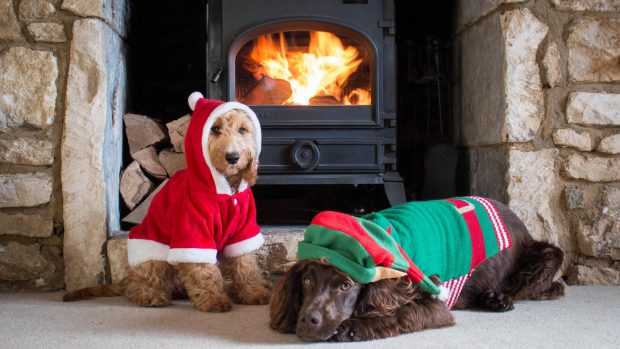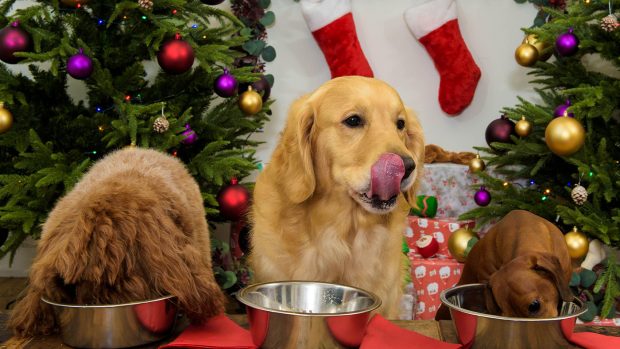If you’re hoping to find out how to house train a dog, it really is relatively simple and straightforward. It’s worth noting that it’s not just puppies that need house training – dogs that have been in rescue for a length of time and dogs brought off the streets into a domestic environment will also need to learn house training.
How to house train a dog
1. First and foremost, when you’re not able to supervise your dog – for example, at night, when you’re out the house, or in another part of the house – make sure they have a small area. This can either be a puppy play pen, a utility room or a dog crate, if necessary, should you be occupied for a several minutes or more. The bigger the area they have to roam, the easier and more likely it is for them to toilet in the house. They particularly like to do this when you are not looking or paying attention. If the weather’s good, it’s a good idea to leave the door open into the garden to encourage them outside as often as possible.
2. Make sure you take the dog outside every hour – especially after they’ve eaten, slept or played. Once outside, you can start to give a command, such as “toilet”. If the dog goes, then give them plenty of praise. It is worth noting that dogs do not like to soil their own “den” bedding area, so if you can keep their area to a minimum while training is in progress, accidents are less likely to happen in the house once they are accustomed to going outside.
3. Sure signs your dog may pee or poo when they are exploring the rest of the house are lots of sniffing and then circling. If you notice this, pick them up quickly and take them outside. If you catch them just as they are about to do it or have just started, I shout “No” and quickly scoop them up and put them outside to finish their business. Again, I praise profusely when this in accomplished.
4. Should any accidents occur, clean up with disinfectant, a good enzymatic cleaner (like this one on Amazon) and some white vinegar to stop your dog peeing in the house and prevent the area from become their “go to” place or marking spot. It is also a wise idea to spray repellents around parts of the home that are inviting to pee on. For young puppies this is usually a rug or carpeted area, while for the older rescue dogs, especially male ones, all areas that have an edge or corner to cock a leg on, including sofas and any other resident dogs’ bed.
5. At night, make their area smaller so they are to soil it, and take your dog out to toilet before going to bed. Wherever possible, make sure the dog is well exercised (if old enough) before leaving them during the toilet training process as they are more likely to have done their business while out and they will be tired more likely to sleep in the day.
House training rescue and street dogs
Rescue dogs and dogs that were recently street dogs will initially have a hard time adapting to not marking anything and everything they come into contact with that smells new. Therefore, it is important you do not get cross with them, but have the patience, kindness and consistency needed to teach them how to toilet outside. This takes time as these dogs have become so accustomed to being self sufficient and marking their dens to keep others away.

Simple Solution Dog Stain & Odour Remover at amazon.co.uk
Use this to eliminate and neutralise tough pet stains and odours, including urine, faeces, and vomit. It breaks down the odour-causing bacteria and prevents repeat marking, too.
How long does it take to house train a dog?
In theory that depends on you, your consistency, the age of the dog and the circumstances the dog came from. The average time it takes to house train most dogs is four to six months. Some breeds are particularly clean – for example, my last two litters of mastiffs were pretty much house trained before they went to their new homes at eight weeks old. I started the process as soon as they were able to walk and go outside to their special fenced area. Other breeds can be particularly difficult to house train, such as French bulldogs or cockerpoos.
If you have a dog with separation anxiety, urinating and pooing can be one of the symptoms of stress. This can’t be put down to lack of house training, but will need addressing all the same.
Little puppies’ bladders and stomachs are much smaller than that of an adult dog, so you can’t expect them to go for huge lengths of time without needing to toilet. They are also fed four times per day, as well as any milk supplement that they still take from their mother.
Some dog owners use puppy pads to aid house training and initially it is a good practice to put several around the door area you would use to let them out. Gradually, over a period of weeks, you will need to remove the pads until there are none left. Leaving them down longer than necessary, however, can make a dog lazy and condition them to toilet on the pad.
Some owners like to have a crate with a surrounding pen and leave the door open, so that the dog may come out of their sleeping area and toilet within the confines of the pen on a puppy pad. The same principle applies to removing pads gradually and also trying to close the crate door in the evening to help with their bladder control as they are less likely to soil their sleeping quarters. The main thing to remember is consistency.

Go Here Puppy Pads at amazon.co.uk
These puppy pads have a liquid-to-gel core, odour control technology, and a built-in attractant to encourage your pup to hit the right spot.

Reusable Puppy Training Pads at amazon.co.uk
These machine washable pads are available in a range of sizes. They can be use in a crate, on the sofa, in the car, on the floor or post-surgery.

Foldable Metal Playpen at amazon.co.uk
Available in a wide range of sizes, this foldable playpen is a great option for sectioning off an area for puppy pad training.
What happens if a dog regresses in house training?
Sometimes you get to the point where you think you’ve cracked it, only to find a puddle or a poo in places you’ve not done before. This is really common and can happen for numerous reasons, including in the following scenarios:
- Once a rescue dog becomes relaxed in their environment and knows the home is their safe place, outside influences, noises or visiting dogs can cause them to mark.
- If a dog lives with an unneutered bitch that comes into season.
- If a dog experiencing a disturbance while you’re not in the house or something scares them, this can cause the dog to soil in the house due to anxiety or mark to let people/dogs know that this is their territory.
- The first hormone rush causes males to begin cocking their leg up corners and sofas, while males and females sometimes pee on sofas and beds.
If your dog or puppy is regressing, it’s best to try to catch them in the act, say “no” sharply and whip them outside quickly. It is then important that you go back to basics. This might not need to be as far back as laying puppy pads again, but simply restricting the area and using the crate if you did so initially, while the association is re-established. Remember to give lots of praise if you need to go back to basics.
The other thing to make sure of is that your dog is not suffering with a urinary tract or kidney infection that is making them wee in the house. Signs to look for include excessive drinking and peeing with not much coming out or blood in the urine. Sometimes a bitch in season can pee and poo in the house due to the pressure on the womb. This is not something to punish but to merely clean up, remove the smell with an enzymatic cleaner and get through the season. Pregnant bitches due to whelp can also do this as the puppies take up more room.
How to house train a dog in a flat
If you live in a flat you have to get creative. If you have a terrace balcony, I’d suggest laying some artificial grass down or what is known as a porch potty (like this one Amazon). Another idea is a large cat litter tray with wood pellets in, which are highly absorbent and get rid of smells, too. This would give your dog a clear indicator in such circumstances of where they need to go to do their business if you are not inside or able to let them straight out to pee and poo in a garden.
These would also be of value to dogs who are recovering from back, knee and cruciate surgery too as they would and should not be going up and down the stairs while on rest. You can also get dog potties with a pee post so there are solutions to most housing set ups.

Puppy Training Tray at amazon.co.uk
This tray has a perforated grate that allows pee to flow down to the pads underneath, while the high sides prevent spatter.
You might also like:

How to stop a dog peeing in the house

How to house train with puppy pads, according to an expert dog trainer

Puppy incoming! How to dog-proof your home ready for the new arrival

11 hacks to eliminate bad doggy smells

Best dog crates: a safe haven for the home and the car

Best dog play pens for security and comfort

Subscribe to Horse & Hound magazine today – and enjoy unlimited website access all year round
Horse & Hound magazine, out every Thursday, is packed with all the latest news and reports, as well as interviews, specials, nostalgia, vet and training advice. Find how you can enjoy the magazine delivered to your door every week, plus options to upgrade your subscription to access our online service that brings you breaking news and reports as well as other benefits.





